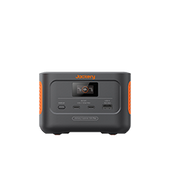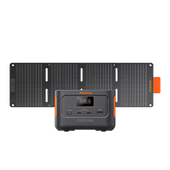Compared to wind energy, solar generators are designed to power most small and large home appliances for long hours. They can help you lower the environmental impact and use free energy. Jackery Solar Generator 2000 Plus is one of the robust solar charging solutions that can charge 99% of home or outdoor appliances.
|
Products |
Image |
Capacity |
Rated/Peak Power |
Battery |
Size |
|
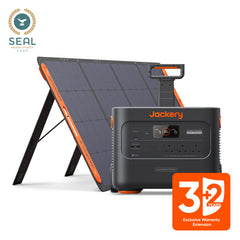 |
2-12kWh |
3000W (6000W Peak) |
LiFePO4 |
Length: 14.7 in (37.36 cm) Width: 18.6 in (47.3 cm) Height: 14.1 in (35.94 cm) |
|
|
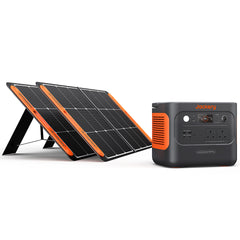 |
1.25-5kWh |
2000W (4000W Peak) |
LiFePO4 |
Length: 14 in (35.6 cm) Width: 10.24 in (26 cm) Height: 11.14 in (28.3 cm) |
What Is Solar Energy?
Solar energy is the sun's radiation that reaches the Earth's surface. When the sun's rays hit the PV cells in the solar panels, it turns the sun's radiation into electricity.
Pros
- The maintenance costs of the solar panels are relatively low.
- Solar energy is more cost-effective and can lead to energy savings.
- With the help of solar energy, you can reduce the reliance on fossil fuels.
- Portable solar generators are generally lightweight and easy to use, providing energy independence.
Cons
- There may be high upfront costs to purchase and install panels.
- Solar panels work if there is sufficient sunlight available.
What Is Wind Energy?
Unlike solar energy, wind energy harnesses the power from wind to produce electricity. The large wind turbines convert the kinetic energy from the wind into mechanical power. The size of the turbine depends on the amount of energy.
Pros
- The wind turbines capture the energy 24*7.
- Turbines capture power anywhere the wind blows, like on rural water, land, and atop buildings.
Cons
- Generally, wind turbines are noisy and large.
- Wind turbines are not as cost-effective as solar for residential and smaller-scale properties.
Wind Vs. Solar Energy
When comparing wind vs solar energy, it's important to understand the four important factors — cost, efficiency, environmental impact, and history. Before we dive deep into which is better between wind and solar energy, here is a quick wind turbines vs solar panels comparison table.
|
|
Solar Energy |
Wind Energy |
|
Efficiency |
The efficiency of solar panels generally lies between 22-25%. |
Compared to solar energy, wind turbines can convert up to 60% of wind energy into electricity. |
|
Cost |
The cost to purchase a solar generator is less than that of wind turbines. |
Wind turbines usually cost more as they have a lot of components. |
|
Environmental Impact |
Solar panels made of silicon cells are recyclable and do not have any harmful impact on the environment. |
While most wind turbine components can be recycled, the blades are an exception. |
|
History |
Solar energy dates back to 700 B.C. and started generating energy after 1839. |
The earliest recorded evidence of wind energy dates back to 6000 to 5000 B.C., but it started generating electricity in the late 1800s. |
|
Pros |
- Sunlight is available almost all the year-around, making solar energy generation a lot easier. - Solar generators do not have any moving components. - Solar panels do not require high maintenance. - Portable solar generators are easier to install and use. They produce little to no noise. |
- The efficiency of solar power panels will be affected depending on their direction. - The initial installation cost might be high.
|
|
Cons |
- Wind turbines can transform more than half the wind that passes through them. - They work in whatever direction they are facing. |
- Wind is intermittent, which means it won't always be moving fast enough to turn the turbine. - They take up a lot of space and might not be ideal for homeowners. They make a lot of noise. |
Efficiency
While there's no doubt that wind turbines can convert 60-90% of energy coming from the wind, they aren't suitable for densely populated areas. You'll generally see wind turbines in rural and windy regions. Unless you have a huge backyard, solar panels are a more practical choice that has a high-efficiency rate between 22-25%.
Cost
Comparing wind turbines vs solar panels cost isn't as simple as it may sound. This is because there are a lot of factors, including energy output, installation cost, tax credits, maintenance, and more, that affect the overall cost. Generally, wind turbines have more components and cost more than solar panels.
Environmental Impact
Although both wind and solar energy are green solutions, the manufacturing, maintenance, and transportation of renewable energy systems impact the planet.
For instance, most components of wind turbines are recyclable. However, the blades are an exception. The solar panels made of silicon cells are readily recyclable.
History
Wind energy dates back to 6000 to 5000 B.C., but it was not until the late 1800s that electricity was generated from kinetic energy. In 1839, the photovoltaic cells came into play when Edmond Becquerel noted the photovoltaic effect.
Wind Vs. Solar: Which One Is Right For You?
When comparing solar panels vs wind turbines, it's clear that solar panels outperform wind turbines in various ways. First, solar panels are great for residential areas because they do not produce any noise. Secondly, portable solar generators can be carried from one place to another for efficient charging.
Most local governments are against installing wind turbines in townships because they create noise and might raise complaints. That being said, wind turbines are not suitable for urban areas. On the other hand, solar panels or solar generators are ideal for most locations that receive sunlight.
Solar generators are easier to install and have no moving parts, making them an excellent choice for home or outdoor needs. If you are looking for a green charging solution that can supply electricity to home appliances, a solar generator can work better than wind turbines.
Jackery Solar Generators Explained
Jackery Solar Generators can be technically referred to as solar power systems that combine Jackery Explorer Portable Power Stations and Jackery SolarSaga Solar Panels. They are ideal and lightweight for homeowners, camping, hiking, and fishing.
The Jackery SolarSaga Solar Panels are manufactured using high-quality monocrystalline silicon cells that capture the sun's rays and convert them to electricity. This electrical energy is transferred to Jackery Explorer Portable Power Stations, where the pure sine wave inverter converts it into usable electricity and powers appliances.

Jackery Solar Generator 2000 Plus
Jackery Solar Generator 2000 Plus features a LiFePO4 battery of 2042.8Wh capacity. With the help of Jackery Battery Pack 2000 Plus, you can expand the capability and capacity to 24kWh. The home battery backup can power 99% of appliances, keeping everything powered during power outages. It also has a 20ms EPS that keeps important appliances like refrigerators and CPAP powered in the blink of an eye when a power outage occurs.

Jackery Solar Generator 1000 Plus
Jackery Solar Generator 1000 Plus is the top choice for similar-level power stations, all thanks to its expandable capacity. With the additional Jackery Battery Pack 1000 Plus, you can expand the battery from 1.25kWh to 5kWh. Hence, the power station can seamlessly provide 1-3 days of home power backup.
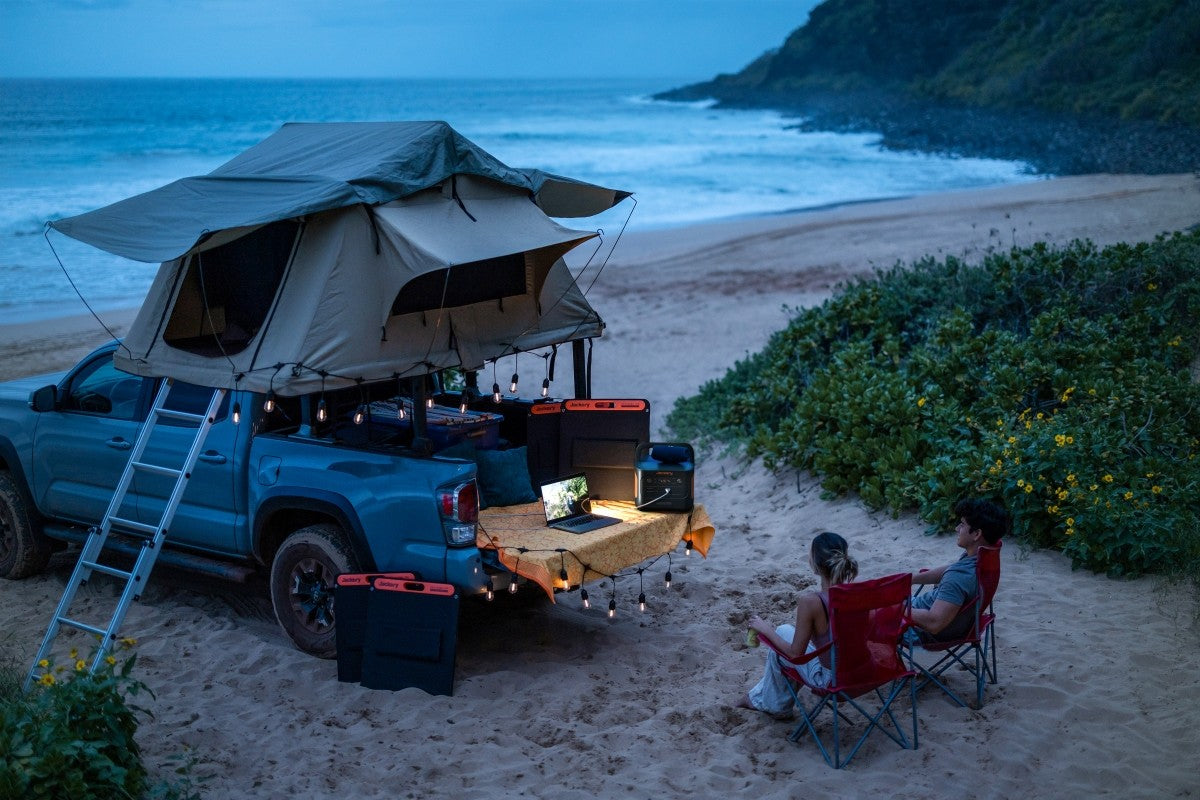
|
|
||
|
Capacity |
2-12kWh |
1.25-5kWh |
|
Lifecycle |
4000 cycles to 70%+ capacity |
4000 cycles to 70%+ capacity |
|
Battery |
LiFePO4 |
LiFePO4 |
|
Dimension |
Length: 14.7 in (37.36 cm) Width: 18.6 in (47.3 cm) Height: 14.1 in (35.94 cm) |
Length: 14 in (35.6 cm) Width: 10.24 in (26 cm) Height: 11.14 in (28.3 cm) |
|
Noise Level |
Less than 30 dB Maximum (Less than a whisper) |
Less than 30dB (Less than that of the library) |
|
Output Ports |
AC Output (×3) 230V~ 50Hz, 20A Maximum AC Output (×1) 230V~ 50Hz, 25A Maximum USB-A Output (x2): Quick Charge 3.0, 18W Maximum USB-C Output (x2): 100W Maximum, (5V, 9V, 12V, 15V, 20V up to 5A) |
AC Output (x2): 230V~50Hz, 2000W (4000W Peak) USB-A Output (x2): 18W Max, 5-5V⎓3A USB-C Output (x2): 100W Maximum, (5V, 9V, 12V, 15V, 20V up to 5A) |
|
Working Hours |
Refrigerator (500W): 3.4H TV (60W): 29H Microwave (960W): 1.8H Electric Grill (850W): 2H Heater (1800W): 57 min Coffee Maker (1080W): 1.6H Portable Air Conditioner (1150W): 1.5H Electric Oven (800W): 2.1H |
Refrigerator (500W): 2.1H TV (60W): 18H Microwave (960W): 1.1H Electric Grill (850W): 1.2H Coffee Maker (1080W): 1H Portable Air Conditioner (1150W): 56 min Electric Oven (800W): 1.3H |
Wind Vs. Solar Energy FAQs
What size of solar generator do I need?
The right solar generator will depend on the number of appliances you want to power and for how long. For instance, if you wish to power more home appliances for long hours, you'll need a larger solar generator. Let's take a simple example to understand:
Suppose you are using Jackery Solar Generator 2000 Plus to charge multiple home appliances, including refrigerator (500W), lights (5W), and CPAP (30W). The working time of Jackery Solar Generator will be:
Working Time = Capacity in Wh * 0.85 / Operating wattage of the appliances = 2042.8Wh * 0.85 / 535W = 3.2H.
Jackery Solar Generators also feature a pass-through charging option that allows you to power appliances while keeping the power station plugged in for charging.
How does solar energy generate electricity? And how is wind energy?
Solar generators consist of power stations and solar panels that work in tandem to generate electricity. When the sunlight falls on the PV solar panels, it generates electricity and passes it to the power station. This is where the usable electricity is stored and supplied to the appliances.
On the other hand, the wind makes the turbine spin where the mechanical energy is converted to electricity. While both solar generators and wind turbines produce electricity, the difference lies in the noise. While the solar generator has little to no noise, the wind turbines are noisy.
Can I use wind or solar power for my home?
One of the biggest differences between wind and solar energy is that the wind production units aren't designed for residential areas. Solar power uses the sun's energy to work — and since sunlight is available in most parts of the world, you can use a solar system to charge home appliances.
Final Thoughts
Renewable energy solutions are becoming increasingly popular among people looking for a sustainable lifestyle. If you are still confused about the wind vs. solar energy battle, consider opting for a safe and quiet solar generator, as solar beats wind for homes in most cases.
While there are residential wind turbines available, they can be difficult to site in many locations. Jackery offers a wide range and sizes of solar generators that efficiently meet your power needs. If you are unsure which size solar generator will suit your needs, you may consider the expandable Jackery Solar Generator 1000 Plus.











